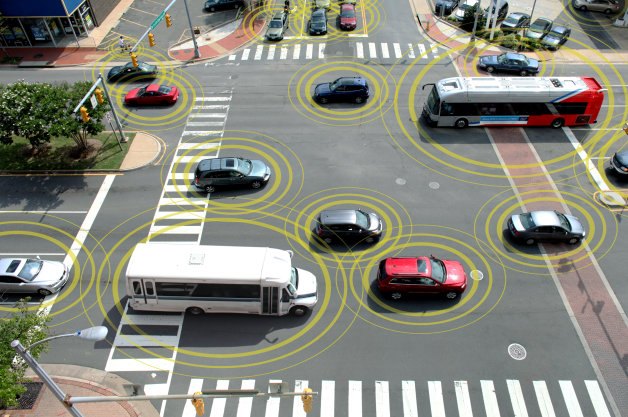FCC Makes Room on the Airwaves for Autonomous Vehicles

Despite the Federal Communications Commission making a mess of net neutrality right now, it remains capable of serving corporate interests and the general public simultaneously. On Thursday, the FCC quintupled the allocation of the radio spectrum used for motor vehicle and aircraft radar systems to help avoid crashes.
While the majority of autonomous cars also use laser guidance and a complex network of cameras to navigate, radar remains an integral component. Presently, the 1 GHz of spectrum set aside in 1995 has been sufficient for self-driving vehicles using adaptive cruise control or automatic emergency braking. But we’re about to enter an era of connected cars that will be required to “speak” to one another, and those vehicles will need plenty of space to talk — 5 GHz of bandwidth, to be precise.
In addition to making it easier for tomorrow’s autonomous vehicles to communicate, the extra bandwidth also allows for better calibration of the radar systems currently in use. Theoretically, a wider wave range should also help autonomous vehicles to better distinguish between objects and be more accurate in estimating their placement on the road.
The decision also places U.S. vehicles on the same spectrum as those in Europe, allowing automakers to bring technologies to the each market more swiftly and engage in more cooperative development projects.
According to Reuters, the National Highway Traffic Safety Association is predicting connected cars could prevent up to 80 percent of non-impaired crashes.
The U.S. Department of Transportation is so stoked on the idea that it has proposed requiring all cars be connected by 2023. Even though persistent valid concerns about the risks associated with connected cars exist, until a terrorists tries to implement a cyber attack on the scale of The Fate of the Furious’ ludicrous car-hacking scene, it should be a net gain for consumer safety. Either way, vehicle-to-vehicle communications will someday become commonplace — and already is on a few models.
Thankfully, auto manufacturers are continuing to roll out new, proven technologies that enable services like collision avoidance, blind spot monitoring, and lane change assistance,” said FCC Chairman Ajit Pai in a statement. “Vehicular radar systems can improve our driving experience and help our families stay safe.”
“By allocating a contiguous 76–81 GHz band to these services, we expand the existing 76–77 GHz allocation for vehicular radars by four gigahertz. We are also moving other vehicular radar operations from other bands to be consolidated into these frequencies. Access to this contiguous block of spectrum will allow for new innovations and the expansion of potentially life-saving vehicular radar technologies.”
[Image: NHTSA]

A staunch consumer advocate tracking industry trends and regulation. Before joining TTAC, Matt spent a decade working for marketing and research firms based in NYC. Clients included several of the world’s largest automakers, global tire brands, and aftermarket part suppliers. Dissatisfied with the corporate world and resentful of having to wear suits everyday, he pivoted to writing about cars. Since then, that man has become an ardent supporter of the right-to-repair movement, been interviewed on the auto industry by national radio broadcasts, driven more rental cars than anyone ever should, participated in amateur rallying events, and received the requisite minimum training as sanctioned by the SCCA. Handy with a wrench, Matt grew up surrounded by Detroit auto workers and managed to get a pizza delivery job before he was legally eligible. He later found himself driving box trucks through Manhattan, guaranteeing future sympathy for actual truckers. He continues to conduct research pertaining to the automotive sector as an independent contractor and has since moved back to his native Michigan, closer to where the cars are born. A contrarian, Matt claims to prefer understeer — stating that front and all-wheel drive vehicles cater best to his driving style.
More by Matt Posky
Latest Car Reviews
Read moreLatest Product Reviews
Read moreRecent Comments
- Jalop1991 is this anything like a cheap high end German car?
- HotRod Not me personally, but yes - lower prices will dramatically increase the EV's appeal.
- Slavuta "the price isn’t terrible by current EV standards, starting at $47,200"Not terrible for a new Toyota model. But for a Vietnamese no-name, this is terrible.
- Slavuta This is catch22 for me. I would take RAV4 for the powertrain alone. And I wouldn't take it for the same thing. Engines have history of issues and transmission shifts like glass. So, the advantage over hard-working 1.5 is lost.My answer is simple - CX5. This is Japan built, excellent car which has only one shortage - the trunk space.
- Slavuta "Toyota engineers have told us that they intentionally build their powertrains with longevity in mind"Engine is exactly the area where Toyota 4cyl engines had big issues even recently. There was no longevity of any kind. They didn't break, they just consumed so much oil that it was like fueling gasoline and feeding oil every time


































Comments
Join the conversation
I imagine this will wreak havoc on radar detector accuracy.
We already get falses from Acuras and Audis (K band). Laser hits come from Volvo, Infiniti and Mazdas. The frequencies allocated for this aren't near "cop radar". I'm always amazed at any story that talks about radio frequency and does not specify the frequencies discussed. Imagine an article about property values...without an address.